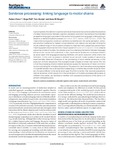Sentence processing: linking language to motor chains
| dc.contributor.author | Chersi, F | |
| dc.contributor.author | Thill, Serge | |
| dc.contributor.author | Ziemke, T | |
| dc.contributor.author | Borghi, AM | |
| dc.date.accessioned | 2018-12-12T12:19:23Z | |
| dc.date.available | 2018-12-12T12:19:23Z | |
| dc.date.issued | 2010 | |
| dc.identifier.issn | 1662-5218 | |
| dc.identifier.issn | 1662-5218 | |
| dc.identifier.other | 4 | |
| dc.identifier.uri | http://hdl.handle.net/10026.1/13025 | |
| dc.description | addendum: [OA] owner: teslar timestamp: 2010.02.03 | |
| dc.description.abstract |
A growing body of evidence in cognitive science and neuroscience points towards the existence of a deep interconnection between cognition, perception and action. According to this embodied perspective language is grounded in the sensorimotor system and language understanding is based on a mental simulation process (Jeannerod, 2007 ; Gallese, 2008 ; Barsalou, 2009 ). This means that during action words and sentence comprehension the same perception, action, and emotion mechanisms implied during interaction with objects are recruited. Among the neural underpinnings of this simulation process an important role is played by a sensorimotor matching system known as the mirror neuron system (Rizzolatti and Craighero, 2004 ). Despite a growing number of studies, the precise dynamics underlying the relation between language and action are not yet well understood. In fact, experimental studies are not always coherent as some report that language processing interferes with action execution while others find facilitation. In this work we present a detailed neural network model capable of reproducing experimentally observed influences of the processing of action-related sentences on the execution of motor sequences. The proposed model is based on three main points. The first is that the processing of action-related sentences causes the resonance of motor and mirror neurons encoding the corresponding actions. The second is that there exists a varying degree of crosstalk between neuronal populations depending on whether they encode the same motor act, the same effector or the same action-goal. The third is the fact that neuronal populations’ internal dynamics, which results from the combination of multiple processes taking place at different time scales, can facilitate or interfere with successive activations of the same or of partially overlapping pools. | |
| dc.format.extent | 4- | |
| dc.format.medium | Electronic-eCollection | |
| dc.language | eng | |
| dc.language.iso | en | |
| dc.publisher | Frontiers Media SA | |
| dc.subject | action chains | |
| dc.subject | embodied cognition | |
| dc.subject | motor system | |
| dc.subject | neural network | |
| dc.subject | sentence comprehension | |
| dc.title | Sentence processing: linking language to motor chains | |
| dc.type | journal-article | |
| dc.type | article | |
| plymouth.author-url | https://www.ncbi.nlm.nih.gov/pubmed/20725506 | |
| plymouth.issue | MAY | |
| plymouth.volume | 4 | |
| plymouth.publication-status | Published online | |
| plymouth.journal | Frontiers in Neurorobotics | |
| dc.identifier.doi | 10.3389/fnbot.2010.00004 | |
| plymouth.organisational-group | /Plymouth | |
| plymouth.organisational-group | /Plymouth/Faculty of Science and Engineering | |
| plymouth.organisational-group | /Plymouth/REF 2021 Researchers by UoA | |
| plymouth.organisational-group | /Plymouth/REF 2021 Researchers by UoA/UoA11 Computer Science and Informatics | |
| dc.publisher.place | Switzerland | |
| dcterms.dateAccepted | 2010-04-27 | |
| dc.identifier.eissn | 1662-5218 | |
| dc.rights.embargoperiod | Not known | |
| rioxxterms.versionofrecord | 10.3389/fnbot.2010.00004 | |
| rioxxterms.licenseref.uri | http://www.rioxx.net/licenses/all-rights-reserved | |
| rioxxterms.type | Journal Article/Review |


